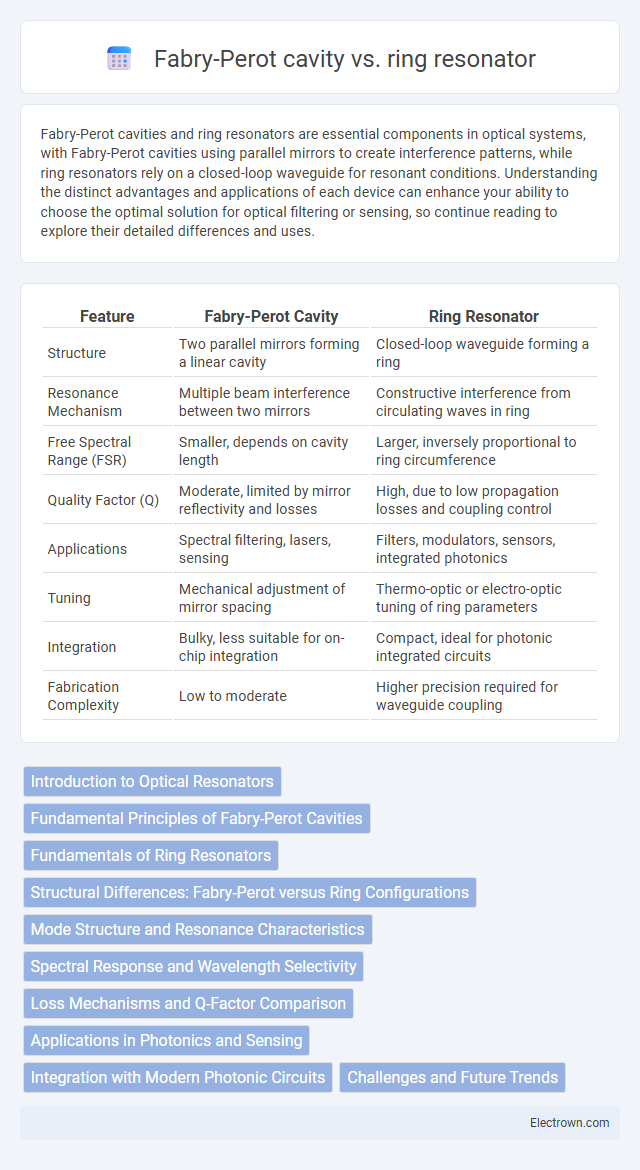Fabry-Perot cavities and ring resonators are essential components in optical systems, with Fabry-Perot cavities using parallel mirrors to create interference patterns, while ring resonators rely on a closed-loop waveguide for resonant conditions. Understanding the distinct advantages and applications of each device can enhance your ability to choose the optimal solution for optical filtering or sensing, so continue reading to explore their detailed differences and uses.
Table of Comparison
| Feature | Fabry-Perot Cavity | Ring Resonator |
|---|---|---|
| Structure | Two parallel mirrors forming a linear cavity | Closed-loop waveguide forming a ring |
| Resonance Mechanism | Multiple beam interference between two mirrors | Constructive interference from circulating waves in ring |
| Free Spectral Range (FSR) | Smaller, depends on cavity length | Larger, inversely proportional to ring circumference |
| Quality Factor (Q) | Moderate, limited by mirror reflectivity and losses | High, due to low propagation losses and coupling control |
| Applications | Spectral filtering, lasers, sensing | Filters, modulators, sensors, integrated photonics |
| Tuning | Mechanical adjustment of mirror spacing | Thermo-optic or electro-optic tuning of ring parameters |
| Integration | Bulky, less suitable for on-chip integration | Compact, ideal for photonic integrated circuits |
| Fabrication Complexity | Low to moderate | Higher precision required for waveguide coupling |
Introduction to Optical Resonators
Optical resonators, such as Fabry-Perot cavities and ring resonators, are key components in photonics used to confine and manipulate light through multiple reflections. Fabry-Perot cavities consist of two parallel mirrors, creating standing waves and high-quality factors essential for lasers and sensing applications. Ring resonators use a closed-loop waveguide, enabling compact integration and wavelength filtering, making them suitable for on-chip optical communication and signal processing, which can enhance your photonic device design flexibility.
Fundamental Principles of Fabry-Perot Cavities
Fabry-Perot cavities rely on the principle of multiple beam interference between two parallel, highly reflective mirrors creating resonant modes at specific wavelengths. The resonance condition depends on the optical path length, mirror reflectivity, and cavity length, enabling sharp spectral transmission peaks and high finesse. Your understanding of these fundamental principles is essential when comparing Fabry-Perot cavities to ring resonators, which use a closed-loop waveguide for resonance instead.
Fundamentals of Ring Resonators
Ring resonators operate based on the principle of light circulating in a closed-loop waveguide, enabling constructive interference at resonant wavelengths. Unlike Fabry-Perot cavities, which rely on two parallel reflecting surfaces, ring resonators achieve resonance through continuous round-trip phase accumulation, resulting in sharp resonance peaks and high-quality factors. This fundamental difference provides ring resonators with enhanced spectral selectivity and compact integration potential in photonic circuits.
Structural Differences: Fabry-Perot versus Ring Configurations
Fabry-Perot cavities consist of two parallel, partially reflective mirrors forming a linear resonating structure, while ring resonators feature a closed-loop waveguide allowing light to circulate continuously. The Fabry-Perot design relies on multiple beam interference, resulting in resonance at specific wavelengths defined by cavity length and mirror reflectivity. In contrast, ring resonators utilize the loop circumference and coupling coefficients to determine resonance conditions, offering more compact integration and enhanced spectral selectivity for your optical applications.
Mode Structure and Resonance Characteristics
Fabry-Perot cavities feature a linear mode structure with standing waves formed between two parallel mirrors, producing sharp, evenly spaced resonance peaks determined by cavity length and refractive index. Ring resonators support traveling wave modes circulating within the loop, leading to resonance conditions governed by the round-trip phase shift and resulting in typically narrower linewidths and higher quality factors. Understanding these differences in mode structure and resonance characteristics is crucial for optimizing Your photonic device performance in applications requiring precise wavelength filtering or sensing.
Spectral Response and Wavelength Selectivity
Fabry-Perot cavities exhibit a spectral response characterized by multiple sharp resonance peaks resulting from constructive interference between two parallel reflective surfaces, offering high finesse and narrow linewidths ideal for precise wavelength selectivity. Ring resonators rely on continuous light circulation around a closed loop, leading to resonance conditions dependent on the ring circumference and effective refractive index, which produces periodic transmission dips in their spectral response with tunable Free Spectral Range (FSR). Your choice between these devices depends on the required spectral resolution and wavelength selectivity, where Fabry-Perot cavities suit narrowband filtering, and ring resonators provide compact designs with adjustable resonance properties.
Loss Mechanisms and Q-Factor Comparison
Fabry-Perot cavities experience loss primarily due to mirror imperfections and scattering, limiting their Q-factor especially in high-reflectivity setups. Ring resonators exhibit intrinsic bending losses and coupling losses, but often achieve higher Q-factors by minimizing scattering and absorption in the waveguide material. Your choice between Fabry-Perot and ring resonators depends on balancing system losses and desired resonance sharpness, with ring resonators typically providing better performance for integrated photonics applications.
Applications in Photonics and Sensing
Fabry-Perot cavities enable high-resolution spectral filtering and laser stabilization due to their precise resonance control, making them ideal for spectroscopy and optical communication systems. Ring resonators offer compact footprints and high-quality factors, supporting wavelength multiplexing and sensitive detection in integrated photonic circuits for biosensing and environmental monitoring. Both structures enhance light-matter interactions, with Fabry-Perot cavities excelling in tunable filtering and ring resonators optimizing on-chip sensor integration and signal modulation.
Integration with Modern Photonic Circuits
Fabry-Perot cavities and ring resonators offer distinct advantages for integration with modern photonic circuits. Fabry-Perot cavities provide high spectral selectivity but often require precise alignment and are bulkier compared to ring resonators. Your choice favors ring resonators for compact, easily scalable, and CMOS-compatible photonic integrated circuits due to their efficient light confinement and flexible coupling configurations.
Challenges and Future Trends
Fabry-Perot cavities face challenges such as limited spectral tunability and sensitivity to fabrication imperfections, which constrain their performance in integrated photonic applications. Ring resonators offer improved wavelength selectivity and compactness but struggle with coupling losses and thermal stability issues. Future trends emphasize hybrid designs combining Fabry-Perot and ring resonator features to enhance device tunability, integration scalability, and robustness for advanced optical communication and sensing systems.
Fabry-Perot cavity vs ring resonator Infographic

 electrown.com
electrown.com